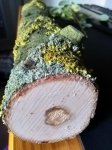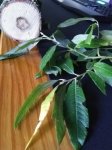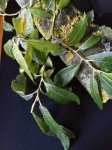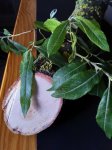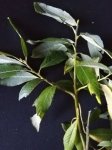Tree/rogue shrub identification
- Thread starter BexL
- Start date
You are using an out of date browser. It may not display this or other websites correctly.
You should upgrade or use an alternative browser.
You should upgrade or use an alternative browser.
I believe it's a buddleia; I do not believe it is considered toxic but I would research it as I have at the back of my mind something to do with not burning it - addled old brain can't recall the details, sorry 
Definitely not buddleia. The leaves are alternate, not budding off from the same point, the bark is greener, less grey than what is usual for buddleia, and the twigs appear more branching whereas buddleia tends to have long stems without branching. Lastly, at this time of year practically every buddleia stem has a flower on on the end (okay, flowers are on their way out, but they will be there).
My vote is going on willow. However I can't decide which of the willows it might be. Doesn't fit perfectly with any of them here:
https://www.woodlandtrust.org.uk/visiting-woods/trees-woods-and-wildlife/british-trees/native-trees/
My vote is going on willow. However I can't decide which of the willows it might be. Doesn't fit perfectly with any of them here:
https://www.woodlandtrust.org.uk/visiting-woods/trees-woods-and-wildlife/british-trees/native-trees/
Last edited:
Yep, you're right about the buddleia. I just nipped out in the daylight to look at the shrub I thought it matched and the leaves are opposite not alternate for a start. It was the pale underside that fooled me. It doesn't actually match any of the willows here either. Are the leaves long enough for crack-willow?
Cotoneaster (as a generic group) was the first thing I thought of, but when I looked for reference pictures I could not find a specific one with the right twig configuration.  Also, the two or three Cotoneaster that I know have much darker and smoother main trunk bark. At this time of year they also tend to be covered in berries, which appear to be absent from the pictured tree.
Also, the two or three Cotoneaster that I know have much darker and smoother main trunk bark. At this time of year they also tend to be covered in berries, which appear to be absent from the pictured tree. 
I think it might be Crack Willow, which would explain the rot in the centre rather well, since they are prone to it.
Where did the better half find this piece of mystery wood?
 Also, the two or three Cotoneaster that I know have much darker and smoother main trunk bark. At this time of year they also tend to be covered in berries, which appear to be absent from the pictured tree.
Also, the two or three Cotoneaster that I know have much darker and smoother main trunk bark. At this time of year they also tend to be covered in berries, which appear to be absent from the pictured tree. 
I think it might be Crack Willow, which would explain the rot in the centre rather well, since they are prone to it.
Where did the better half find this piece of mystery wood?
Thanks for the replies folks  it certainly looks like crack willow might be the winner here. It was on a quiet lane near Heapham, Lincs. A tree had lost it's branch by the roadside so he pulled over and rescued it.
it certainly looks like crack willow might be the winner here. It was on a quiet lane near Heapham, Lincs. A tree had lost it's branch by the roadside so he pulled over and rescued it.
I'm guessing it's a black willow going from those leaves as they are smooth edged, Crack willows have serrated leaves. Also looking at the way the rot is spreading through such a young branch is a plus one for willow. Also the growth rings are just one colour and vessels being similar size throughout the year indicating the tree is diffuse porous, plus one for willow.
Similar threads
- Replies
- 16
- Views
- 417
- Replies
- 6
- Views
- 477

